Practical fire safety - existing high rise domestic buildings: guidance - updated March 2021
This guidance provides practical fire safety advice on how to prevent fires and reduce the risks from fires in high rise domestic buildings.
Chapter 5: Risk Management – Physical Fire Safety Measures
122. Benchmarks are useful for assessing whether existing fire safety measures are appropriate. This Chapter discusses how these can be used and offers benchmarks for measures such as fire separation, escape routes, smoke control, stairways and travel distance. There are also specifications for fire resisting doors and fire detection systems and facilities and assistance of firefighters.
Key points
- Benchmarks are used to assess the standard of existing fire safety measures.
- Upgrading buildings to meet current benchmarks may sometimes be appropriate where there is unacceptable risk.
- When upgrading fire safety measures, fire protection products and services should be fit for purpose and properly installed.
- Third party certification schemes are available for many products and services.
Methodology for using benchmarks
123. This Chapter is concerned with the physical fire safety measures necessary for a satisfactory standard of fire safety. The principles behind these measures are discussed in Chapter 2. The aim of these measures is to ensure people's safety escaping a fire and those remaining in their flats. The Guidance sets out:
- The standards recommended by design codes and guides for the design of high rise domestic buildings.
- The commonly found differences between newly built and existing high rise domestic buildings designed to comply with the standards at the time.
- Possible solutions where the standards have not been maintained in line with the original design intent, or falls far short of the standard considered acceptable today.
124. It is important to compare the standard found in a particular high rise domestic building against appropriate benchmarks before making judgements about the adequacy of the fire safety measures when carrying out a fire safety risk assessment, or otherwise reviewing fire safety design.
125. Benchmarks allow the standard of safety in a particular block to be assessed, by allowing comparisons. They should not be seen as prescriptive standards. Fire risk assessors and others, need to make judgements when assessing fire safety.
126. The objective is to establish whether the departures from benchmarks create significant risk and, if they do, to determine a realistic solution that can be implemented within the constraints of an existing building.
127. When assessing the adequacy of fire safety measures in existing high rise domestic buildings, the standards that applied when it was built should be established. These should be used to determine how far removed the original standards are to what is acceptable today, and if this gives rise to an unacceptable level of risk.
128. While many of the principles have not changed, there have been variations in the design of high rise domestic buildings over time and changes to some of the approaches to applying these principles. For example, since May 2005, automatic fire suppression systems, 60-minute fire resisting self-closing flat entrance doors and strict requirements regarding external wall cladding systems have been introduced through Building Regulations.
129. With older high rise domestic buildings, it may be difficult to discern the original design intent and whether it has been preserved or altered subsequently. Similarly, it can be difficult to determine the fire separation standard achieved, given that elements of structure are often hidden and inaccessible.
130. Retrospectively upgrading existing buildings to meet current benchmarks should only be done where the level of fire risk justifies it, taking into account the time, cost and disruption involved.
Consideration for Assessment
The following sets out main aspects for assessing physical fire safety measures.
Third-party certification
131. All fire safety measures, fire protection products and related services should be fit for purpose, properly installed and maintained in accordance with the manufacturer's instructions or a relevant standard.
132. Third-party certification schemes for fire protection products and related services provide assurance of quality, reliability and safety. Goods and services that are not third-party approved are not necessarily less reliable, but there is no obvious way in which this can be demonstrated.
Fire separation
133. Fire separation provides fire resistance between individual flats, between flats and the common areas, and to enclose lift wells. Design guidance recommends the following:
- Separating floors and separating walls to be non-combustible.
- Separating floor to have a minimum fire resistance of 120-minutes.
- Separating wall between a flat and any other part of the building to have a minimum fire resistance of 60-minutes.
- Separating wall enclosing a lift well to have a minimum fire resistance of 60-minutes.
- Self-closing fire doors in separating walls to have a minimum fire resistance of 60-minutes.
134. The standard of fire separation recommended in design guidance has changed over time and as a result, there are variations in the construction and in the periods of fire resistance in buildings. Previous design standards permitted a lower level of fire resistance.
135. Separating floors and walls need to be in good condition and with no openings, whether intentional or unintentional, that would permit the uncontrolled spread of fire and smoke.
136. The fire-resisting enclosure of flats should include:
- flat entrance and other doors,
- internal windows into an access corridor,
- glazing above or around the flat entrance door doorways, or
- hatches in walls for access to read meters or for deliveries.
137. Obvious openings between floors, and in walls between flats and other ancillary accommodation and the common areas, should be considered in a risk assessment. Particular attention should be paid to service ducts or service risers and any common heating or ventilation systems.
138. Where balconies have been infilled and incorporated into flats, the adequacy of fire separation and fire stopping between flats should be considered.
139. Ducted heating, ventilation or air conditioning systems that serve dwellings should be arranged so that they do not transfer fire and smoke. This may involve fire resisting construction and fire dampers.
140. The adequacy of fire stopping around any openings in walls and floors for services such as; gas, water, electricity, telecommunications and drainage should be considered. These may be present where such services enter from the common areas or pass between flats. In some cases, the extent of openings and fire stopping can only be ascertained through intrusive inspections and by opening up panels in kitchens, bathrooms and other areas.
141. Small bore pipes, typically less than 40 mm in diameter, are not normally considered to be of concern. Larger pipes, especially if made of a combustible material, could allow significant fire and smoke-spread. Proprietary fire seals, including externally mounted collars, or fire-resisting enclosures are used in new buildings and could be used in older buildings. However, the difficulties of retrofitting such seals in occupied flats may mean that it is only practicable to undertake this on a long-term basis when flats become vacant.
142. In some high rise domestic buildings, common ventilation ducts are used to provide extract from bathrooms and, less commonly, kitchens. These ducts can run the full height of the building, serving a large number of flats and terminate at roof level.
143. It has been the practice for many years for the common extract from bathrooms to incorporate shunt ducts to link each flat to the common shaft, to reduce the likelihood of fire and smoke-spread between flats (Figure 2). Some early designs used the same arrangement for kitchen extract. There may be buildings that do not incorporate shunt ducts and have no adequate means of preventing fire and smoke-spread between flats via ventilation ducts. The absence of such measures to prevent fire and smoke-spread via common ventilation systems is far removed from what is acceptable today and action should be taken to reduce the risk it poses.
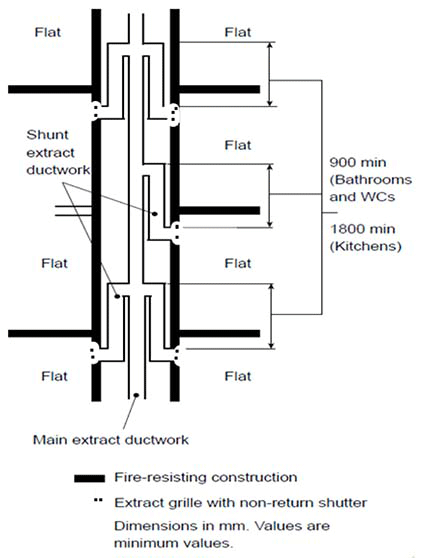
144. It will rarely be practicable to retrospectively introduce mechanical fire and smoke dampers into the ventilation ducts in flats. One option to reduce the potential for fire spread between flats is to retrofit intumescent fire dampers to the vents into the ducts. Although this would not restrict the spread of smoke in the early stages of a fire, it would prevent spread of flames and hot gases. This is a reasonable approach for bathrooms but not for kitchens, where there is the potential for a serious fire. A possible solution would be to rearrange the ventilation to discharge directly to outside and not via a common duct.
Escape routes within the common areas
Buildings where flats are served by a single escape stairway.
145. The design guidance for flats with a single escape route from a flat entrance door to the stairway is:
- Every flat is separated from the common escape stairway by a protected corridor or protected lobby.
- The travel distance between the flat entrance door and the door to a lobby or stairway is limited to 10m.
- smoke control is provided by natural or mechanical ventilation in each lobby or corridor adjacent to the stairway
- the stair has a vent at the head
Buildings where flats are served by more than one escape stairway
146. The design guidance for buildings with more than one escape stairway and alternative routes from the flat entrance door to a stairway is as follows:
- Every flat is separated from each escape stairway by a protected corridor or protected lobby.
- The travel distance from a flat entrance door to the door to the nearest stairway or stair lobby is limited to 30m.
- Any dead-end section of an access corridor is separated from the rest of the corridor by a self-closing fire-resisting door – the single direction of travel in the dead end section of corridor should be limited to 10m.
- Smoke control by natural or mechanical ventilation is provided in each lobby or the corridor adjacent to the stairway to protect the stairway.
- There is a vent at the stair head
147. Figures 3 and 4 show these arrangements.
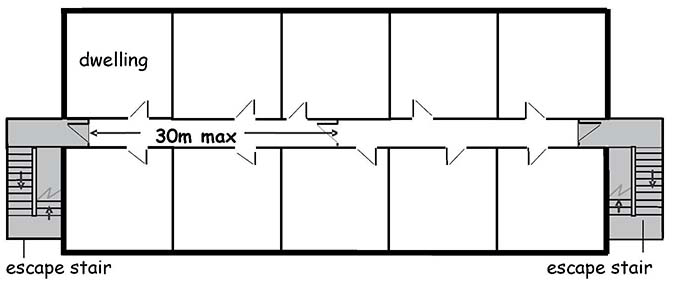
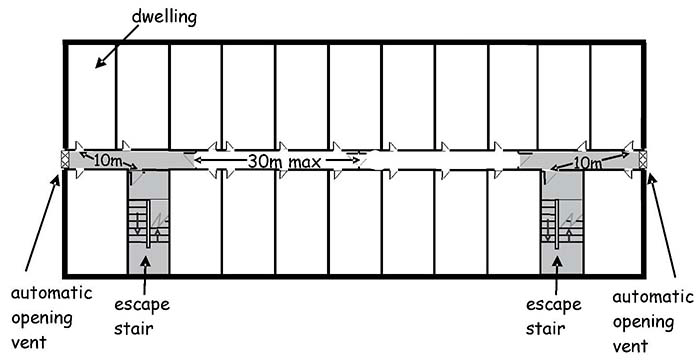
Flats with communal external balcony or access deck approach
148. If the width of the access balconies or decks are less than 2m, there is deemed to be little risk of horizontal smoke spread along the balcony or deck from a fire in a flat which would prevent residents from using the escape route. There is, however, potential for smoke-spread along balconies or decks wider than 2 m. In these situations, downstands (minimum 300 mm deep) may restrict the lateral spread of smoke.
149. Ideally, there should be no stores or other ancillary rooms, located off the balcony or deck.
150. The maximum travel distance for a common access balcony or deck is 40m. For flats with external balcony or deck approach and the balcony or deck provides two directions of escape, there are no limitations on travel distance in the common escape routes. The distances specified for fire-fighting access do apply.
151. For flats with a single direction of escape to a single escape stairway, the separating walls between the flats and the balcony or deck should be fire-resisting up to a height of 1.1 m from balcony or deck level. The flat entrance doors in these situations should be self-closing fire-resisting doors (minimum 30-minutes). This will allow residents, if they need to pass a fire in an adjoining flat, to reach the stairway. In flats with alternative independent escape to another balcony or deck on the same level, which leads back to the single stairway, only one of the enclosures between the flats and the balcony needs to be fire-resisting.
152. Where there is alternative escape available from each flat entrance along the open balcony or deck to two or more escape stairways, the separating walls between the flats and access balcony or deck and the balcony flat entrance doors are not required to be fire-resisting.
Travel distance
153. Small increases in travel distance can be accepted in most situations without any additional measures. Where there are significant increases in travel distance additional measures may need to be considered and may include:
- Additional cross-corridor doors to restrict smoke-spread.
- Improvements to the smoke control arrangements.
Protected corridors or lobbies
154. The corridors and lobbies used for escape are protected routes enclosed in construction with at least 60-minutes fire resistance.
155. Ancillary rooms, risers and other areas opening onto corridors and lobbies also need to provide this level of protection. Doors from ancillary rooms should be fire-resisting. The benchmark for doors opening into corridors and lobbies is a minimum of 60-minutes fire resistance and – with the exception of risers and ancillary rooms – the doors should be self-closing.
Stairways
156. Stairways are enclosed in fire-resisting construction to protect the escape route from fire and smoke. The benchmark for stairs which also provide a fire-fighting shaft is a minimum fire resistance of 120-minutes. Self-closing fire doors in the structure are a minimum fire resistance of 60-minutes.
157. Stairways should lead directly to a final exit. The stairways should not contain any significant fire hazards nor, ideally, anything other than lifts or protected electrical meter cupboards. Ideally, gas installations should not be located within protected stairways.
158. A stairway width of 1m would normally be considered adequate for means of escape. With a stay-put policy, the number of people expected to use a stairway at the same time in the event of a fire will be limited.
159. In single stairway buildings the stairway should not continue down to serve a basement or enclosed car park. In multiple stairway buildings, where the stairways serve basements and car parks, one of the stairways should terminate at ground level. Other stairways may extend to serve basements, providing they have lobby or corridor protection at basement level.
160. A single stairway should not serve a boiler room, fuel storage room or other similar high-risk ancillary rooms. In multiple stairway blocks of flats, the ancillary rooms should normally be separated from the stairways by a protected lobby or protected corridor.
Smoke control
161. Measures are provided for smoke control in protected lobbies, protected corridors, fire-fighting lobbies (see Chapter 2) and escape stairs. Smoke control can be achieved by natural means (using the buoyancy of smoke) or mechanical means. Natural ventilation efficiency, in particular, often depends upon the prevailing wind.
162. With natural ventilation, lobbies and corridors are ventilated where they join a stairway, at a high level, by an automatically opening external wall ventilator (AOV) direct to open air or via a natural smoke shaft. AOVs which discharge direct to the external air should have a minimum area of 1.5 m2. A smoke shaft rises up through the building and is usually found where the lobby or corridor does not have an external wall to allow direct ventilation to open air. It has a minimum 1.5 m2 opening at roof level and AOVs in each lobby into the shaft should have a minimum 1 m2 area. Replacement air is supplied by an AOV in the adjacent stairway. The shaft should have a minimum fire resistance of 60-minutes and all ventilators have a minimum fire resistance of 30-minutes. On detection of smoke in the protected lobby, the ventilators on the fire floor, at the top of the smoke shaft and the 1m2 ventilator at the head of the stairway should all open simultaneously. The ventilators from the protected lobbies on all other storeys should remain closed.
163. Protected stairways should have means to ventilate smoke from the stairway. A vent of at least 1 m2 is normally provided at the head of the stairway. This vent is usually operated manually even if electrically powered. Where an AOV is required as part of a smoke shaft arrangement, the vent should be configured to operate if smoke is detected in any protected corridor or protected lobby. In older properties, openable vents at each level may be provided in lieu of a stair vent at the head of the stair.
164. It is important that firefighters can control the opening and closing of the ventilators on arrival at the building. Ventilators should be fitted with a simple handle or lock that can be easily operated by firefighters. If ventilators are not easily accessible they should be operated by a mechanism positioned at the SFRS access point in the building. In the case of an escape stair and fire-fighting stair, a local control should also be provided at the topmost storey. This will allow firefighters flexibility in their operations.
165. Electromagnetic holding devices for ventilators have been known to fail under fire conditions due to a loss of power or weakening magnetic fields as temperatures in and around the smoke shaft increase. In light of this, fire safety risk assessments should be reviewed and consideration given to replacing them with more robust vent actuators.
166. A mechanical smoke control system can be a mechanical ventilation system or a pressurisation system. A mechanical ventilation system extracts from the lobby or corridor by creating a negative pressure in the space using fans. Most systems use a vertical shaft. The shaft contains an AOV of 1 m2 at the top storey. A pressurisation system works on the basis of forcing air into a space to create a positive pressure to prevent smoke from entering. Pressurisation systems are most commonly found protecting stairs.
167. Any system installed to maintain environmental conditions, should be arranged so that it does not compromise the function of the smoke control system. In the event of fire, the system should either automatically shut off or, if it is integrated with the smoke control system, should operate in fire mode.
168. When assessing existing smoke control systems, it is appropriate to review the arrangements according to the standards in place at the time the building was built, and to determine whether it functions as originally intended. Existing arrangements may be able to be left in place, and maintained as originally designed. It may not be appropriate to commit expenditure to restore older, non-functioning systems to their original design if effective smoke control could be installed in line with modern standards.
169. Corridor smoke control design has changed over time. Previous design guidance included a smoke dispersal strategy, with reliance on cross-ventilation of corridors, uninterrupted by cross-corridor doors. The cross-ventilation could be provided by permanently open vents (PV), manually operated vents (OV) or automatically opening vents (AOV) operated by smoke detectors.
170. Smoke dispersal using PVs is no longer seen as an acceptable method of smoke control. It has been shown to be vulnerable to failure as a result of wind direction or being undermined by residents blocking the permanent vents because of discomfort. In high rise domestic buildings designed with corridor smoke dispersal systems, consideration should be given to providing cross-corridor doors and to change to a smoke containment approach, but maintain the OVs or PVs to ventilate the sections of corridor remaining. Advice from a specialist should be sought if smoke dispersal is present in a single stairway building.
Surface finishes in common escape routes
171. It is important to control the fire performance of linings within the common areas since the surface finishes of walls and ceilings can significantly affect the rate of fire-spread and contribute to the development of a fire. Combustible surface finishes should not be permitted in escape corridors, lobbies or stairways. Products and materials that will afford at least European class B-s3, d2 performance (BS EN 13501-1) are normally necessary for use in the common areas.
172. A wall or ceiling constructed of non-combustible materials, such as masonry, brick, concrete or has plaster finishes, will generally have an acceptable surface spread fire performance characteristic.
173. It is often difficult to identify existing surface finishes. Surface finishes normally considered acceptable may have been subject to many instances of over-painting that can affect their performance when exposed to fire. Multiple layers of paint applied to walls and ceilings in the common areas can give rise to rapid fire spread. In these situations, where the risk is considered significant, action should be taken to remove or treat the paint. Proprietary products are available to treat the surfaces to provide a protective outer coating that will reduce the extent of fire-spread.
174. Any false ceilings in common corridors and lobbies should preferably be non-combustible (A1 or A2).
Fire-resisting doors
175. A 'fire door' is a fire-resisting door which is rated by performance to fire under test conditions. Fire doors are used to prevent fire spread and for the protection of means of escape. A self-closing device is a normal feature of a fire door, though there are some exceptions such as doors to small cupboards which are kept locked shut.
176. A fire door rated to 30 minutes is described as FD30 (tested to BS 476: Part 22) or E30 (tested to BS EN 1634: Part 1). A suffix is added to denote that the door has a smoke seal function giving FD30S and E30Sa respectively. A 60 minutes fire door with smoke seal is designated FD60S or E60Sa. The door rating is an indication of test performance and is not necessarily how a door will perform in a real fire.
177. The level of protection provided by a fire door is determined by the time taken for a fire to breach the integrity of the door assembly, together with its resistance to the passage of smoke, hot gases and flame. The gap between the door leaf and the frame is normally fitted with intumescent strips, in either the door or the frame (but not at the bottom of the door). The strips expand in response to heat from a fire, to seal the gap between the door leaf and the frame. Smoke seals fitted to the door leaf gap prevent the spread of smoke at ambient temperatures, before an intumescent strip expands.
178. In determining the performance of a door in fire, it is necessary to consider the whole door assembly including the frame, glazing, side-panels, transoms and ironmongery. Manufacturer's installation instructions should be followed for a new door assembly.
179. Doors protecting the common escape route between a flat and the escape stair, including flat entrance doors, are specified as minimum 60-minute fire-resisting self-closing doors (designated FD60S). Letter boxes would incorporate intumescent material which seals the opening when exposed to the heat from a fire. Current design guidance requires that fire doors forming part of the stair enclosure should also be a minimum of 60-minute fire resisting and self-closing.
180. Older doors should have complied with the test standard or specification of the day for 30-minute fire-resisting doors. They may lack intumescent strips and cold smoke seals and rely on 25 mm door stops. Flat entrance doors may not have protected letterboxes. Where older doors were self-closing, this was sometimes achieved by using rising butt hinges (Figure 5). Many of these older doors may have performed satisfactorily in a fire situation and are likely to continue to do so, providing they remain in good condition and are effectively self-closing from any angle.
181. Existing doors should not be replaced simply because they are not fitted with intumescent strips or smoke seals, or fail to meet some other requirement of current standards. It will normally be acceptable, taking into account the fire risk, to accept existing fire-resisting doors and not replace the doors as a matter of course. It may be appropriate to consider door replacement as part of refurbishment work.
182. Upgrading existing letterboxes in flat entrance doors to meet current standards is not always necessary and will depend on the location of the flat in the building, and the location and construction of the letterbox in the door.
183. Fire-resisting flat entrance doors, and doors to protect common corridors, lobbies and stairways, should always be fitted with suitable positive action self-closing devices. The self-closing device should be capable of closing the door in its frame from any angle and overcoming the resistance of any latch. Rising butt hinges (Figure 5) are unreliable and should not be used. The fitting of suitable self-closing devices – whether to replace rising butt hinges or because the doors are not fitted with self-closing devices – should be a priority.
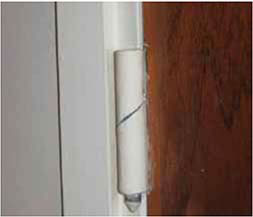
184. There are three options for original fire-resisting doors that do not meet current standards:
- Accept the door as it is, provided it is a good fit in its frame, is in good condition, and that it satisfied the standard applicable to fire-resisting doors at the time of construction of the building.
- Upgrade the door by fitting intumescent strips and smoke seals along the edges, and in the case of flat doors, fitting a protected letter box.
- Replace the door with a new FD60S door.
185. A flat door that opens directly onto a single stairway should always be FD60S. A flat entry door on an external balcony or deck access does not require a fire-resisting letterbox.
186. Where a fire-resisting flat entrance door has been inappropriately replaced with a non-fire-resisting type, the non-fire-resisting door should be replaced with a new FD60S door.
187. Testing of fire doors in 2018 by the UK Government's Ministry for Housing, Communities and Local Government (MHCLG) identified that some existing glass reinforced plastic composite fire doors failed to demonstrate the claimed period of fire resistance duration. Composite fire doors may have been used as flat entrance doors. Where doors that have failed tests are installed, building owners should review their building fire safety risk assessments and consider how quickly these doors should be replaced. Test evidence should indicate that both sides of the door have been tested and meet the criteria required. Further information can be found at https://www.gov.uk/guidance/fire-door-investigation.
Flat internal arrangements
188. In older high rise domestic buildings where flats open directly onto stairways, the protection of the internal hallway may have been a safeguard for the communal escape route. Living room and kitchen doors may be solid fire doors, closing onto a 25 mm rebate and self-closing, while bedroom doors are often hollow core domestic doors, without any substantial doorstop.
189. It is not uncommon to find that residents have either changed internal fire doors to non-fire-resisting doors or have removed doors or partitions altogether.
190. Where flats open directly onto stairways with no protected corridor or lobby, and where the provision of common lobbies is not a realistic proposition, additional fire safety measures may be required. They will be determined by the fire safety risk assessment process and may involve one or more of the following: enhanced levels of fire detection and warning, FD60S self-closing fire doors, protected enclosures within flats, the provision of smoke control facilities or automatic suppression systems. What is appropriate will ultimately depend on the level of risk.
Fire safety signs
191. High rise domestic buildings with a single staircase should not usually require any fire exit signage. In buildings where there are alternative exit routes or where there is any potential for confusion, fire exit signage may be required.
192. In general, 'Fire Door Keep Locked Shut' signs should be provided on the following fire-resisting doors:
- The external face of doors to store rooms.
- Electrical equipment cupboards.
- Ancillary rooms located within the common areas.
193. 'Fire Door Keep Shut' signs should be provided on both faces of fire-resisting doors forming part of the protection to the common escape routes and on cross-corridor fire doors, but not to flat entrance doors. In the case of fire doors that are held open, but then close on operation of smoke detectors (unusual in high rise blocks), the signs should read 'Automatic Fire Door Keep Clear'. New safety signs should comply with BS EN ISO 7010.
Lighting on escape routes
194. Adequate artificial lighting and emergency escape lighting should be provided in common escape routes, such as corridors, lobbies and stairways, to enable safe use.
195. Emergency escape lighting should conform to the recommendations and requirements of the relevant parts of BS 5266. It should provide illumination for three hours in the event of power failure.
196. One or more test switches should be provided, so that the emergency escape lighting can be tested by simulating failure of the normal power supply to the luminaires without the need to isolate normal lighting circuits.
Refuse and chute rooms
197. There should be access to a chute room directly from the open air or by way of a protected lobby with permanent ventilation. It should be separated from other parts of the building by at least 60-minute fire-resisting construction.
198. Where chute rooms are in stairways or corridors they should be enclosed in fire resisting construction and have permanent ventilation direct to open air and designed so it does not prejudice any escape route in the event of fire.
199. Refuse chutes and access hatches which open directly onto protected corridors, lobbies and stairs have the potential for the spread of fire and smoke to the common escape routes. In these situations, an automatic fire-resisting shutter should be fitted at the base of the refuse chute to restrict the spread of fire and smoke from a fire in the refuse room. The shutter should be operated on a fixed temperature fusible link. A suppression system located over the bins should be considered where access hatches open into protected stairways or lobbies serving flat entrance doors.
Fire detection and alarm systems
Individual flats
200. Individual flats should have smoke and heat alarms to give an early warning of fire.
201. The benchmarks in this Guidance take account of the introduction of the new Tolerable Standard for Housing, which will apply to all tenure of housing, from February 2022. Smoke and heat alarms should be installed in accordance with BS 5839-6, in the following areas:
- One smoke alarm in the circulation space (on each storey in the case of maisonettes).
- One smoke alarm in the living room.
- One heat alarm in the kitchen.
202. Alarms should either be mains-powered and with an integral stand-by supply, or powered by tamper-proof long-life lithium battery. They should be ceiling mounted and interconnected to maximise the audibility of the fire alarm signal. Models interlinked by wiring or radio are available. It is preferable that smoke alarms incorporate an alarm silence control, so that false alarms do not cause unnecessary or prolonged disruption to residents.
203. Generally, new smoke alarms installed in flats should be the optical type. These are less prone to false alarms from kitchens, and they respond better to slow smouldering fires. In a circulation area close to a bathroom or shower room, a multi-sensor type should be used.
204. Where a resident has significant hearing impairment and is likely to be alone within a flat, smoke alarm equipment complying with BS 5446-3 should be used. These incorporate one or more flashing beacons to alert when awake, and vibrating pads to wake when asleep. A vibrating pager can also be incorporated.
205. Existing smoke alarms may fail to meet benchmarks in a number of areas. They may be ionisation chamber type, removable-battery operated, mains only with no stand-by supply, and will often be only provided in circulation areas, and not be interconnected.
206. When any major electrical wiring takes place in flats, smoke alarms with accessible batteries (and mains-operated smoke alarms without a standby supply) should be replaced with alarms that meet current benchmarks. The introduction of a new Tolerable Standard will make this provision mandatory.
In the common areas
207. There is no requirement in Building Regulations to install a communal fire alarm in high rise flats. Fire detection and alarm systems are not normally provided in the common areas of high rise domestic blocks and this has been the position for many years.
208. It is usually undesirable to provide a communal fire alarm system and domestic smoke alarms are not appropriate for the common areas of blocks of flats. This is because should fire detection activate in a common area, residents may be placed at increased risk should they be alerted and choose to leave their flat to investigate or evacuate.
209. Only in very limited circumstances would it be necessary to consider the installation of a communal fire alarm system (see Chapter 2).
210. Smoke detectors may be installed to automatically operate smoke vents serving the common areas. No fire alarm sounders should be connected to these detectors.
Locks and access systems
211. Locks fitted to flat entrance doors and alternative exit doors from flats should be easily operable by the residents from the inside without the use of a removable key.
212. Flat entrance doors should, where possible, be fitted with a suitable lock that can only be locked on the outside with a key operated deadlock, but can still be opened from the inside by a handle or lever without a key. As flat entrance doors are required to be self-closing, there is a risk that self-locking security devices on the doors could accidently lock residents outside their flats. As well as being a general nuisance for residents, there is a risk during a fire if residents leave their flat and dependent family members are inside.
213. Residents may fit additional locks, and, in some cases, security grilles and gates to entrance doors and secondary exits. Residents should be advised of the risks these may present to their safety in the event of a fire in their own flat. Any security locks, grilles or gates should be easily openable without a need for a key. The fitting of these should not impair the effective self-closing of flat entrance doors.
214. External grilles or gates should not be used where they present a risk to the residents, impinge on the safety of others, or pose difficulty for the fire and rescue service.
215. All final exit doors from the building should be easily openable from the inside without the use of a key or code. A simple turn handle or lever is preferred. Any exits fitted with electronic locking mechanisms must fail-safe on power failure and have a standby power supply. In some situations, it might be necessary to consider the provision of override controls in accordance with BS 7273-4.
216. When void flats are secured, it is important that the flat entrance door remains of a type that is fire-resisting and self-closing.
Facilities and assistance for firefighters
Fire-fighting facilities
217. Fire-fighting facilities are provided in high rise domestic buildings to assist the Scottish Fire and Rescue Service. The current design guidance for fire-fighting facilities is:
- Provision of a fire-fighting shaft, consisting of a fire-fighting stairway (at least 1m wide) with fire-fighting lobbies (at least 5m2); a rising fire main; and a firefighters lift.
- The fire-fighting shaft should have an overall enclosing structure at least 120-minutes fire resistance. Self-closing fire doors in the enclosing structure should be at least 60-minutes fire resistance.
- A fire-fighting lobby is not needed where access to the flats is from an open access balcony.
- An escape stair can also be a fire-fighting stair if it meets the relevant criteria.
- A wall separating a fire-fighting stair from a fire-fighting lobby should have at least 60-minutes fire resistance and the self-closing fire door should have at least a 30-minutes fire resistance.
- The firefighters lift allows firefighters to take control. It should be located in a protected area and constructed in its own compartment with at least 60-minutes fire resistance. The lift landing doors need achieve 30-minutes fire resistance. The firefighters lift should only be entered from a fire-fighting lobby with not more than one door to the room or storey it serves, or an open access balcony.
- Rising fire mains with outlets located in a protected lobby, protected corridor or open access balcony.
- If the block has a storey above 50 m height, the rising fire main should be a wet main (the threshold for a wet rising main in previous guidance was 60 m). No point on the storey should be more than 45 m from the rising fire main outlet. If the building is fitted with an automatic fire suppression system, no point on the storey should be more than 60 m from the outlet.
- A parking space for a fire appliance located no further than 18 m from each rising fire main inlet.
- An evacuation alert system for SFRS use. This enables SFRS to activate fire alarm sounders within each dwelling on any single floor, multiple floors or the entire building, according to circumstances (introduced 1 October 2019).
- Signs identifying the storey by "Floor Number" and flat number indicators should be located on every landing of a fire-fighting stairway and every fire-fighting lobby (or open access balcony) served by a firefighters lift (introduced 1 October 2019).
- Ventilation should be provided to every escape stair, fire-fighting stair, fire-fighting lobby and to every protected lobby. A natural or mechanical smoke ventilation system used to protect the means of escape may be used to satisfy the requirement for ventilation for fire-fighting.
- Ventilators should be fitted with a simple handle or lock that can be easily operated by firefighters including where automatic opening ventilators are provided. If ventilators are not easily accessible they should be operated by a mechanism in the building at the fire and rescue service access point. In the case of an escape stair and fire-fighting stair, a local control should also be provided at the topmost storey.
- Ventilation to every escape stair and every fire-fighting stair should be by:
- a ventilator of at least 1 m2 at the top of the stair, or
- a ventilator of at least 0.5 m2 at each storey on an external wall, or
- smoke shafts.
- Ventilation in protected lobbies, protected corridors and fire-fighting lobbies should be by:
- a ventilator of at least 1.5 m2 at each storey on an external wall, or
- smoke shafts.
218. Figures 6 and 7 show typical floor arrangements with firefighting facilities. Figure 8 shows fire resistance rating.
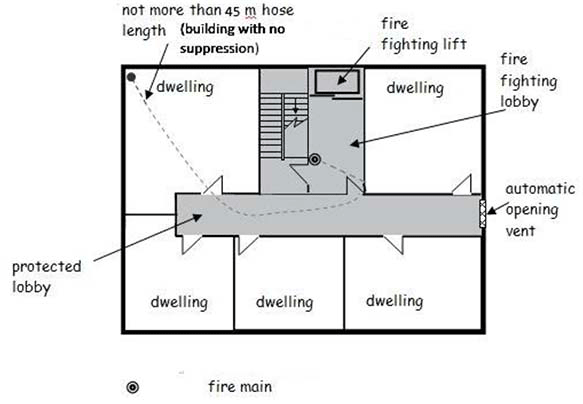
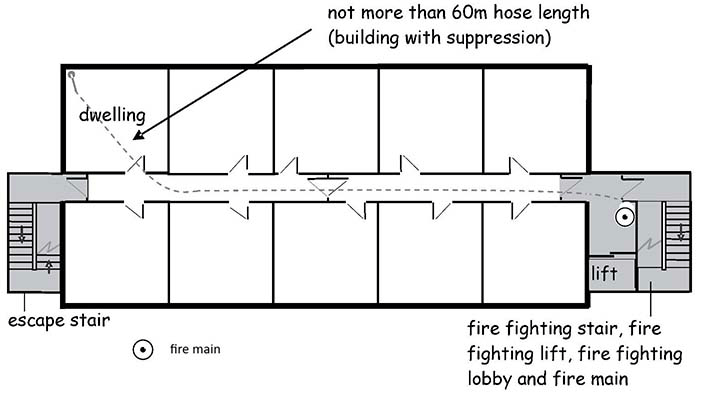
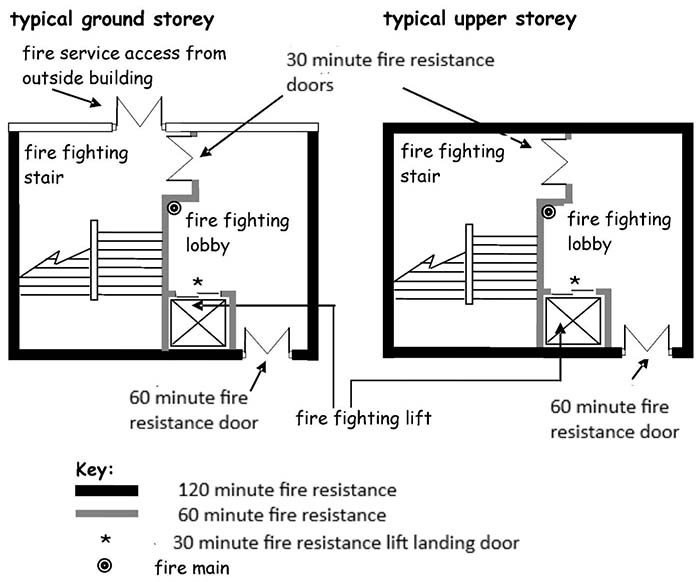
219. The facilities provided to assist firefighters should, at least, meet the standard when the building was designed and should be maintained in efficient working order. Where the fire-fighting facilities are not in accordance with current standards, the advice of the fire and rescue service may be needed. It may not be possible, or even appropriate, to consider upgrades to meet current benchmarks.
Entrapment risk
220. The entrapment of firefighters in cabling that has fallen or become displaced due to exposure to heat is a contributory factor in firefighter injury and fatalities. This is often the result of plastic products or fastenings for installation (securing) of cabling. In high rise domestic buildings this is most commonly plastic trunking or conduit and underslung cable trays secured with plastic cable ties.
221. Most common plastics will fail at an early stage in a fire. Where this happens there can be a 'spider's web' of cables hanging to ensnare firefighters. Firefighters often work in reduced or zero visibility and this can be compounded by their complex and restrictive clothing and breathing apparatus.
222. BS 7671 requires that existing plastic cable management solutions need to be supplemented by metal fixings to ensure they are not the 'sole means of supporting' cables to avoid premature collapse in a fire.
Information
223. A standard external plate should be displayed for the assistance of the SFRS at an incident. These plates display relevant information on the layout of the building, its services and firefighting facilities (Figure 9).
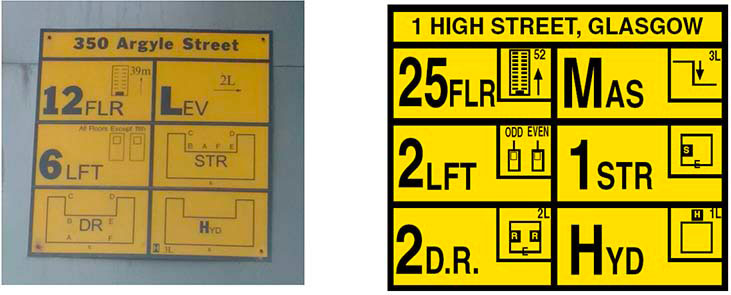
224. Firefighters tackling a fire in a high rise building will access the fire via the stairs – even where part of the journey may be via the firefighters lift. Floor levels and flats should be clearly numbered so that firefighters can identify them in a fire.
225. SFRS may hold information on the provision and operation of smoke control systems in its risk database. There should also be information displayed at the control panel explaining the system operation.
External fire-spread
226. The external facades of high rise flats should not provide potential for fire spread. Particular attention should be given to wooden balconies, balcony infills, spandrel panels and rain-screen or other external cladding systems.
227. The use of combustible cladding materials and extensive cavities can present a risk in high-rise buildings. Restrictions are normally applied to the nature of materials and their fire propagation and surface spread of flame characteristics. Cavity barriers are also required. Since May 2005, building regulations have required external wall cladding to be non-combustible or meet the test performance specified in BR 135.
228. Assistance from specialists may be required to determine if the construction and materials are satisfactory and whether there is adequate provision of cavity barriers.
Contact
Email: FireDivision@gov.scot
There is a problem
Thanks for your feedback